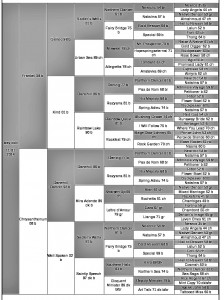The two richest turf races on Dubai World Cup night were won by Just A Way (Heart’s Cry ex Sibyl by Wild Again) and Gentildonna (Deep Impact ex Donna Blini by Bertolini). Both Heart’s Cry and Deep Impact are sons of Sunday Silence whose dominance in Japan matched Sadler’s Wells in Europe and their sons Deep Impact and Galileo are now equally pre-eminent.
European breeding is urgently in need of some new options and it lacks even the limited diversity available in the US. Crossing and recrossing Sadler’s Well and Danehill surely can’t go on forever.
We have quickly seen the decline of sire lines such as Sharpen Up, Ahonoora, Busted and Blushing Groom. Nijinsky as an atypical Northern Dancer was to be welcomed but is almost gone. The bright spot that was the total outcross Monsun is perhaps likely to end up as a National Hunt influence as his sons are pushed into that space. Mill Reef’s influence is on the wane and the Roberto line is barely hanging on.
It would be nice to see some new options emerge and to me the failure of any major European stud to go all out for a top representative of the Sunday Silence line is surprising. Vita Rosa spent had a year at Lanwades without much support or success but Divine Light was a lesser son of Sunday Silence who still sired a classic winner in Natagora and Hat Trick sired Dabirisim before being moved to Kentucky. The Wildenstein’s sent their mare Bastet to be bred to Deep Impact and were rewarded with Beauty Parlour who won a French Guineas. Overall that is a good strike rate for the Sunday Silence line in Europe and it is not difficult to see a well credentialed sire backed by a major European stud making a major impact (a deep impact even 🙂 ) on the European scene.
Coolmore have done deals in Japan in the past (even Danehill spent a year there in 1996) and maybe they would consider swapping a top son of Galileo (how many do they need?) for a high class representative of the Sunday Silence line. Just a thought….

